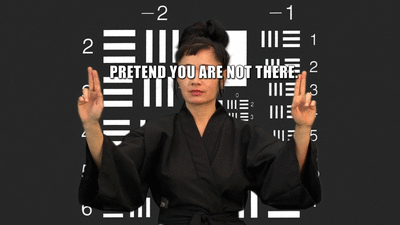 GIF extract form Hito Steyerl, How Not To Be Seen. A Fucking Didactic Educational .MOV File , 2013. HD video file, single screen, 14min.
GIF extract form Hito Steyerl, How Not To Be Seen. A Fucking Didactic Educational .MOV File , 2013. HD video file, single screen, 14min.
In May and June, the most viewed page on Rhizome was an artwork by Jonas Lund, We See in Every Direction. Part of ongoing series The Download, Lund's piece is an an application for anonymous, communal web browsing that has found an active user base. Whenever one opens it, there are usually several other strangers logged in, often sharing a browsing experience in multiple languages. During this time, the most commented-upon page on Rhizome was Orit Gat's examination of the political affinities attached to URLs in the cases of .art and .sy, which prompted some good responses from Tom Moody in particular.
In what could be seen as a kind of reaction against the "New Aesthetic," with its technologically sublime idea of a world increasingly shaped by the machine's point of view, several articles on Rhizome in May and June put the "anthro" back in "anthropocene," re-asserting the importance of human bodies and desires and general weirdness in technological discourse. Jacob Gaboury wrapped up his five-part history of queer computing, arguing for "the importance but broad relevance of an affective sexual archive" of technology history. In an interview about his performances for data centers, Tyler Coburn wrote, "I attempt to work against the deterministic mindset that new technologies produce and delimit new forms of subjectivity and sociability." Harry Burke framed the the forthcoming program at Arcadia Missa as an exploration of human subjectivity in a networked age. And, Jesse Darling introduced a curated series of Performance GIFs with contributions by Maja Cule, Legacy Russell, Jaakko Pallasvuo, Creighton Baxter, Genevieve Belleveau, Jennifer Chan, Marisa Olson, and Dwayne Strike.
Ceci Moss covered Il Palazzo Enciclopedico at the Venice Biennale and The Whole Earth in Berlin, asking whether images of the world can still inspire new worlds. Brendan Byrne interviewed McKenzie Wark about the legacy of the Situationists and how it applies to these technological times, after which Rhizome ran a much-discussed Guy Debord action figure giveaway.
In the wake of an event in Venice, Italy at the Palazzo Peckham with Oliver Laric and Hito Steyer, Michael Connor wrote about Steyerl's new piece How Not to be Seen: A Fucking Didactic Educational .MOV File, which came to seem especially topical in the wake of revelations about the extent of NSA surveillance and Edward Snowden's attempt to, well, disappear.
Michael Connor investigated the Whitney Museum's restoration of The World's First Collaborative Sentence by Douglas Davis, and in an in-depth interview with Oddworld creator Lorne Lanning, excavated the technological basis for many of Jack Goldstein's paintings. Tom McCormack wrote about John Whitney's analog computer and its use for the film Vertigo.Gene McHugh argued for the reappraisal of holographic artist and avant-garde musician Peter Van Riper; Alexander Keefe delved into the sci-fi constructivism of a Colombian artist;
Prosthetic Knowledge offered a selection of works on the theme of privacy, works making use of turntables and records, works that explore the relationship between painting and video gaming and works that bridge the gap between art and gaming. Zoë Salditch offered Surf Reports on the subjects of gURLs and Millennials.
Adam Rothstein described the experience of participating in a fake TEDx conference; Giampaolo Bianconi wrote a nice reflection on Jan Robert Leegte's Remake of Robert Smithson's Spiral Jetty in Minecraft; Michael Connor read a press release on e-flux about Cory Arcangel's exhibition at DHC/ART. Orit Gat previewed Eva Weinmayr's Twitter play #Downing_St, which was followed by over 9,000 users.

